1830 to 1931
1839-42 First Opium War. It led to the Treaty of Nanjing, giving Britain Hong Kong and increased the number of treaty ports from one (Canton) to five.
1854 Commodore Perry first met with the Japanese (although Washington gave permission to do so in 1852). He had a substantial force for the meeting, publicised to the world beforehand (Perry would not be turned away lightly). The Japanese government wanted to turn him away but knew they were outgunned.
1856-1860 Second Opium War. Britain took advantage of the Qing government’s problems with the Taiping Rebellion to further their trade. A protracted war resulted in GB taking Kowloon and gaining more trade advantages.
1859 By this year, all the major powers had access to Japanese markets and to the key ports. Some also had the law of extraterritoriality agreed upon, whereby foreigners could not be tried in Japanese courts, regardless of their crime.
1860 PM Naosuke assassinated because of his policy of compromising with foreigners.
1868 Meiji Restoration. This was a political and social revolution in Japan from 1866 to 1869 that ended the power of the Tokugawa shogun and returned the Emperor to a central position in Japanese politics and culture. It is named for Mutsuhito, the Meiji Emperor, who served as the figurehead for the movement.
1871-73 Iwakura mission, government representatives sent to Europe to gather information.
1894-95 War with China. It was fought over the influence for the Korean peninsula, arguably started by the Japanese by fermenting dissent to Chinese influence. China responded but the ensuing Japanese victory was a surprise to all.
1902 Anglo-Japanese Alliance. This cemented Japan’s growing stature in the world. Britain signed it because of the growing threat of Japanese naval forces to its colonies in Asia and Russian expansionism.
1904-5 Russo-Japanese War. Japan proved itself to the world that it could rival the strongest powers.
1910 Japan annexed Korea, it was formerly a protectorate in 1905. She knew the West would not object.
1921 Japanese Communist Party, controlled by Comintern (USSR).
1921 Washington Conference. One aim was for the West to limit Japan’s naval capability. The ratio of 5:5:3 for US:GB:Japan was not well received at home. And a Four-Power Pact (France added) replaced the Anglo-Japanese alliance. However, she extracted concessions that Guam, Singapore and Hong Kong would not be reinforced.
1930 London Naval Treaty. Aimed to limit the size of all ships (Washington 1922 was for the larger only ). The Japanese Navy (modelled on the British Royal Navy) was against this as it would make it difficult to defend the Pacific from the West (especially the US). However, the government overruled this.
Documentary Questions – Part 1
The period from 1868 (the end of the Tokugawa Shogunate) to 1931 had several themes.
- Growing nationalism. Some in Japan were fearful of foreign influences, using the changing culture, events such as the Opium Wars and unfair treaties, as examples (a Chinese phrase was used to describe this – ‘naiyu-gaikan’ or ‘troubles at home, dangers from abroad’. The country had been largely isolated from foreign influences for centuries to protect their culture so fear from abroad may be part of the Japanese psyche. A consequence of this feeling was the forming in the 1920s of ‘Patriotic Societies‘, nationalist groups which were popular with Army officers and responsible for moving the country to the Right.
- Resentment of China. Despite much of Japan’s culture being influenced by China, the growing nationalism and military defeats it endured led to a dislike of the country and a belief that they were inferior.
- Cultural and conservative beliefs. The Japanese religion of Shintoism gave the emperor imperial divinity and Confucianism, obedience and a code of personal behaviour. This went against some of the beliefs and behaviour of the West.
- Distrust of Foreigners. Despite the growing power of Japan, there was still a feeling that foreign powers did not see them as equals. They did not receive what they wanted from the Treaty of Versailles and naval treaties did not seem fair either. Japan had copied Western systems, a cabinet-government, a constitution (modelled on France and Germany) and adopted their culture. It seemed that regardless of what they did, foreigners would always see them as inferior – at Versailles, Japan asked for a racial equality clause to be inserted…it was rejected. Even when the Japanese Communist Party was set up in 1921, the fact that it was controlled from Moscow only increased distrust of foreigners for some.
- Economy. The manufacturing and export of silk drove the economy, agriculture and textiles were secondary to this. Exports to the US were especially important although China’s growing textile industry was becoming a threat to Japan’s economy. Furthermore, the catastrophic earthquake of 1923 hit Tokyo and Yokohama killing over 100 000 people hit it hard (as evidence of Japan’s developing racism towards others, 6000 Koreans were tortured and murdered by police after the earthquake). When you factor in the growing population, 35 million in 1873 to 60 million in 1925, economic concerns increasingly affected Japan’s desire for more natural resources and improved trade links. Even though capitalism had improved economic growth for the country, the inequality gap had grown, especially for the rural population. They could potentially be supporters of the Right in Japan.
- Rearmament. As a consequence of foreign influence, distrust and growing nationalism, Japanese governments invested heavily in their armed forces. With each military success (China, Russia, WWI) the clamour to continue rearming was maintained.
- Manchuria. In the late-19th century and early 20th, Japan began to increasingly rely on the resources of Manchuria. It had moved forces into the region after the First Sino-Japanese War of 1894-95 and there they remained to maintain a Japanese influence. Ishiwari Kanji, military strategist and future general, argued that Manchuria should be fought over. However, this would only be the first war of many to come, leading to Japanese dominance in Asia. But in 1924 Chaing Kai-Shek became the Chinese nationalist leader (of the Kuomintang). He began campaigning in 1926 to take control of the Yangtse region and the north (threatening Japan’s control of Manchuria which was under Chang Tso-lin, who receptive to Japan). This was a huge problem for the government.
1931-41
The beginning of the decade gave two choices to Japan: to join with China to take Asia forward and change the balance of power OR to protect a weak China from the West by occupying it and making use of their resources to build a strong Japan. The government became increasingly influenced by the military and the second option became policy.
Key Events
The Great Depression was clearly a factor in this decision (although the US and Germany were affected much more than Japan). It led to a decrease in Japanese exports (1 billion yen between 1929 and 1931), with the textile trade (silk) and farmers especially suffered the most. Rural poverty rose as a result. The devaluation of the yen increased exports but the Depression led to increased imports.
In 1931 PM Hamaguchi Yuko was assassinated, killed by a nationalist. He was succeeded by a similarly thinking Hashimoto Sakurakai. This led to a failed coup by the nationalists; the leaders only given lenient sentences because of their patriotic beliefs.
Itagaki Seishiro and Ishiwara Kanji (two staff officers in the Kwantung Army) were anxious of the effects of the global depression, in particular it reduced the profits of the South Manchurian Railway. A collapse of the company would severely affect Japan’s ability to acquire the resources it needed.
Manchuria and the Mukden Incident, 1931. The Kwantung Army took the initiative and arranged a bomb to explode on the railway. The government knew beforehand and sent a messenger to prevent it, however, he was involved too and went ‘slowly’ so as to give time for the plot to succeed. Soldiers were sent into southern Manchuria, (troops had been in China since the Boxer Rebellion and those from Korea were also involved). The war spread to southern China even into 1932 (to Shanghai and Nanking).
A puppet was installed, previous Manchu emperor Pu Yi, (also in Korea) in ‘Manchukuo’.
The League of Nations sent Lord Lytton to find a solution. Japan’s argument was that the situation was merely Chinese internal problems and they were protecting Japanese business interests there. However, the League ruled against them and this ultimately led to their withdrawal. Why would a western-led organisation rule against them for imperialist policies that they themselves were still maintaining? The decision only reaffirmed their belief of inequality and prejudice to Asian people.
Importantly, the actions of the Kwantung Army were decided independent of Tokyo. This was to be a factor in Japanese affairs for the 1930s or the Second World War. Moreover, the constitution made the emperor commander in chief and in charge of the armed forces, not the government.
1931: Political assassinations and the failed coup prevented a strong government. Even when a coup succeeded, lenient sentences were handed out. BUT 1936 – Young Officers’ coup, killing the PM’s brother-in-law. It failed and thirteen were executed and many were demoted if a lesser involvement.
During this time, the Left were arrested suppressed. 1925: Peace Preservation Law gave the police more powers to arrest anybody guilty of overthrowing the government. In 1928, the police rounded up thousands of communists, a year later thousands of anti-government supporters. By 1945, 75 000 people had been arrested under this law.
Takahashi Korekiyo (finance minister 1931-36) was responsible for taking Japan out of recession. He abandoned the gold standard to reduce the value of the yen and increase exports. Government monies went into agriculture (it grew slightly) and other industries (chemicals, ship-building, metals – which all did well in terms of production). Military spending increased (it rose from 9% GNP from 1933-37 to 38% from 1938-42) and this influenced other industries. However, as Korekiyo was assassinated in 1936, a key figure who could have restrained military spending was gone.
The military put forward a five-year plan to produce more iron, steel, oil, electrical power etc. 1938: National Mobilization Law gave the government (military) more power over the economy and country to control labour and materials.
Why War in China?
Two reasons for building on the 1931 expansion into China: secure itself from the threat of Jiang Jieshi AND a small advance in NE China would bring much needed coal, iron and steel.
1936: Fundamentals of National Policy – this contained the features of the New Order and Co-Prosperity Sphere. These included the elimination of tyrannical leaders in Asia. And to build a strong coalition of Japan, China and Manchukuo. Northern China would be a special region because of the economic significance and SE Asia would be gained peacefully in time.
The trigger was 1937 Marco Polo Bridge. It did not immediately lead to war but Japanese forces began to arrive on mass. By the end of the year, 200 000 soldiers were in the field. Once the fighting had begun, Tokyo had no power to stop it. The military had decided policy once again.
The war began with successes for Japan but the Guomindang did not surrender. As the European war began in 1939, France and GB were in no position to stop Japan and allowed access through their colonies. Moreover, the actions of the soldiers in Nanking (the Rape of Nanking) shocked the world and could have been a factor in failed diplomatic efforts with the West prior to Pearl Harbor. Indeed, Japanese actions against China had persuaded some in Roosevelt’s Cabinet (US Ambassador to Japan, Joseph Grew was one).
Student Summaries
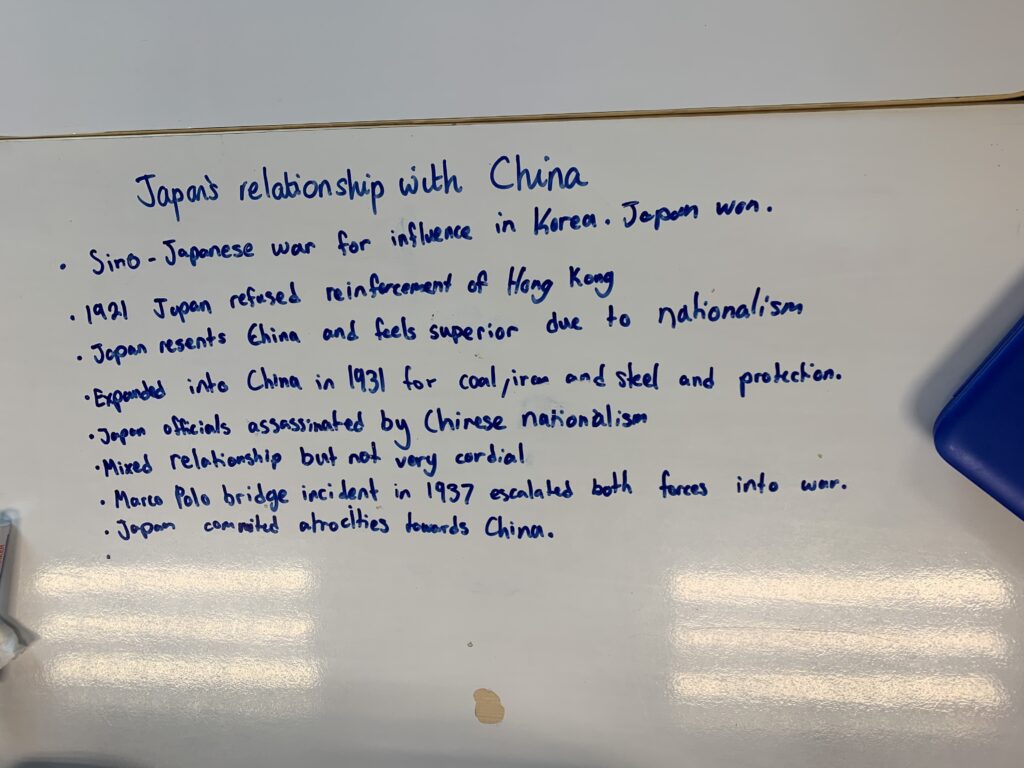
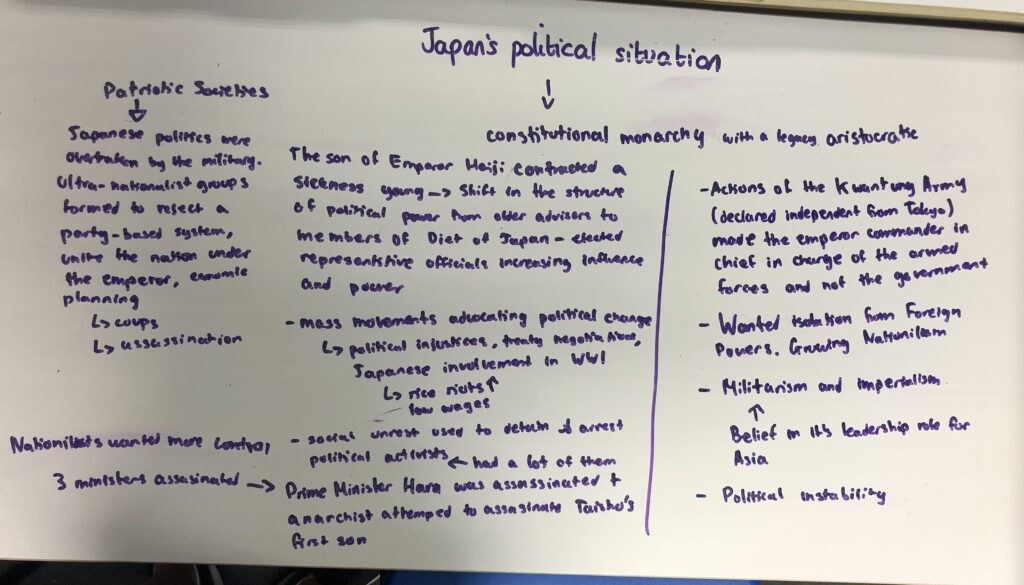
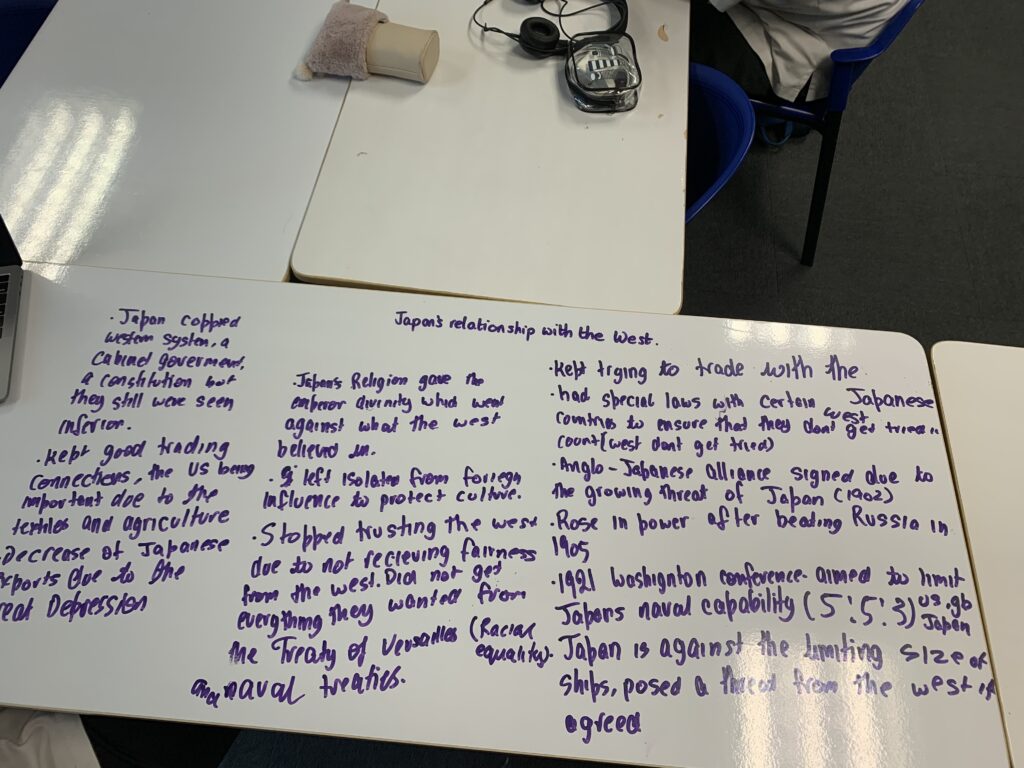
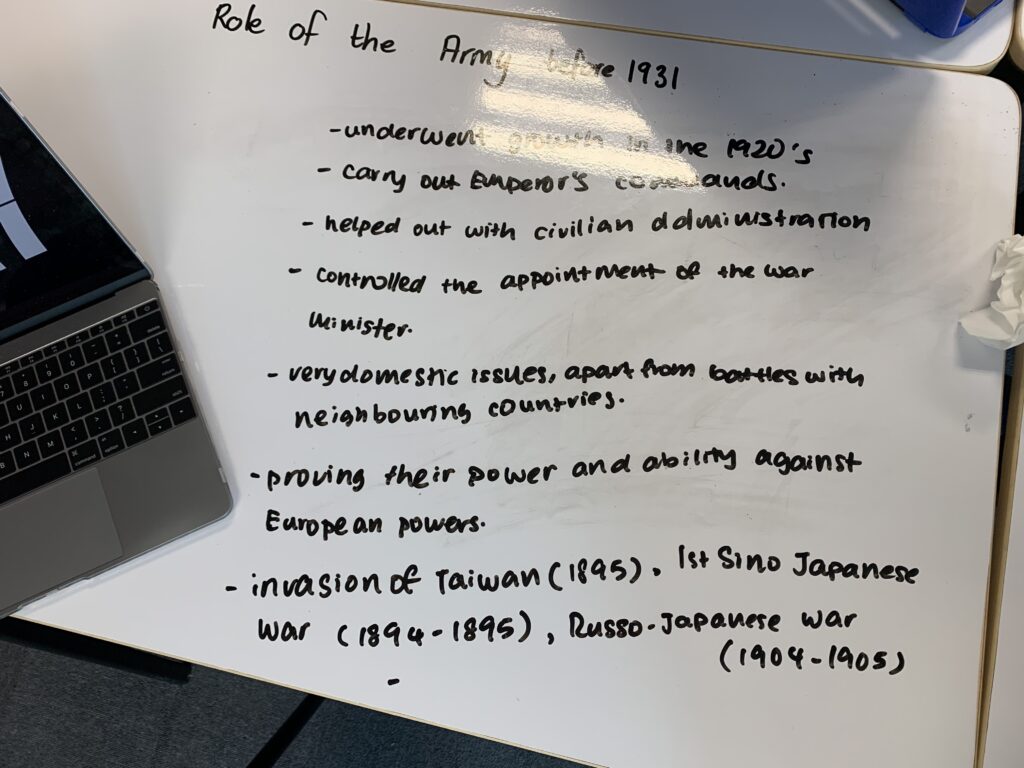
Sources
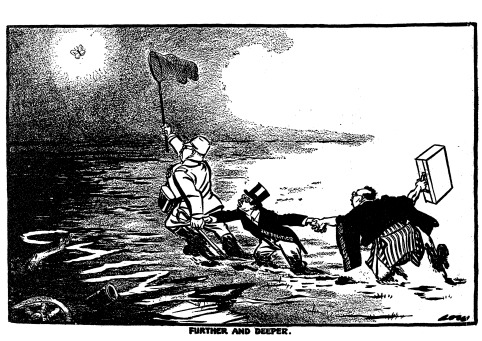
This source is a political cartoon titled “Further and Deeper” and was published in the UK newspaper The Evening Standard on January 19, 1938
From https://www.thinkib.net/history/page/20454/3-japanese-expansion-in-east-asia-1931-1941-atl
Why war against the West in Asia?
After Europe became embroiled in war in 1939, it was clear to Tokyo that European colonies were defenceless. Their strategy was then to either strike south to SE Asia or north to acquire East Asia (antagonising Russia into a possible conflict). Tokyo could not decide.
The war in Europe brought strategic advantages for Japan but economically it made it difficult. The demand for oil has risen, as it had for tungsten, iron, tin, rubber, etc. SE Asia could supply many of these and Indonesia oil. The USA was also a possible source of supply.
Japan first pressed France for access into SE Asia, it gave way easily. But the Dutch were more stubborn with Indonesia. The continued war in China brought sanctions against it from the Dutch and the USA (July 1941). Relations with the West had not been good because of the Japanese alliance with Germany and the US policy of supplying arms to China (the US was concerned about her own interests in the area (Philippines) so acted to limit the power of Japan.
The 1 Reason Imperial Japan Attacked Pearl Harbor: Oil
Japan had to make a decision for war quickly as time was running out. It knew that most of the US military was weak but their navy was growing at a rapid rate during the 1930s. The longer Japan waited, the less chance it had to defeat the US. It did so but the civilians in the government disagreed. It continued to use diplomacy to acquire the oil embargo to be lifted for example but to no avail. The argument for the south became the preferred policy because of the Japanese failure at the Battle of Khalkin-Gol in 1939 (arguably, this also had an influence on Japan’s refusal to declare war on the USSR after the invasion by Germany in June 1941. It turned down the German request to go to war and preferred to remain neutral). Furthermore, after nearly a decade of war, the Cabinet was dominated by military appointments. Although the navy was less aggressive than the army, the latter won through, arguably their ‘Bushido’ culture affecting their decision-making.
There were several ‘hawks’ in the Japanese Cabinet, none more so than Yōsuke Matsuoka, the foreign minister. He purged his ministry of any supporter of either the US or the UK, and was instrumental in signing the Tripartite Alliance with Italy and Germany. Another was Hideki Tojo, Prime Minister in 1941-44. He argued strongly for a war against the US to prevent the West…
Finally, arguably the most important individual was Admiral Yanamoto. It was his opinion to go to war which swayed the Cabinet to support the policy. He was not sure himself about war with the US (he had served as a naval attache in Washington and understood their defence capabilities) but if there was to be a conflict, he wanted to lead it. Consequently, for the attack against Pearl Harbor, he was the man to plan and execute it.
The decision to attack the US was taken in July and August 1941 although planning had begun in January. The occupation of southern Indochina and the US oil embargo had both influenced the decision. They established the Greater East Asia Co-Prosperity Sphere at this time, their ambitions clear as the area included many western colonies.
Was there an alternative?
Japan did pursue diplomatic avenues but not enough. Indeed, their Ambassador to the US, Admiral Nomura, met representatives of Roosevelt’s administration throughout 1941, but the military dominated the policy-making. Furthermore, even when Prime Minister Konoye tried to negotiate with the US after August, the army and Imperial Council gave him both a tight deadline to succeed and demands which were likely to be rejected.
The Japanese government was not a dictatorship like Germany and Italy. Their respective leaders had vast amounts of power and took their countries to war. Emperor Hirohito was the spiritual leader of Japan and the commander of the armed forces. Had he intervened in the plans to create the Greater East Asia Co-Prosperity Sphere, or objected to them, war with the West could have been averted.
Tokyo could have pursued only the possessions of European states. They could have reached a deal with Washington that the Philippines and Hawaii were not territorial ambitions of theirs.
Strategy
Pearl Harbor was attacked December 7 1941, Hong Kong surrendered Christmas Day, Manila, Kuala Lumpur and Singapore in January 1942. Indonesia was taken in March. The decision to attack Pearl Harbor was justified in the name of defence. If Japan did not act soon, the US would cut off their access to the raw materials they needed. The initial strategy was to attack the only force capable of stopping a future operation for the Philippines and the Indies – the US Navy at Pearl Harbor. If the operation was undertaken first, Japan itself would be vulnerable to a US attack as their forces would be indisposed in their southern offensives.
Japan, or Admiral Yamamoto, judged that the war against the US should be swift. If it was fought for longer than two years, it could not win. Therefore, a huge knockout blow, via a surprise attack, was planned. It would be so devastating that America could not recover for years.
Perspectives
The Pacific Campaign by Dan van der Vat, argues that the war was brought about by the blind obedience of the Japanese people to the generals and admirals and those who supported them.
Judgements
Q. How much was the West to blame for Japan’s growing nationalism?
From Japan’s perspective, the West was both hypocritical and aggressive during the 1930s. It pursued imperialist policies around the world but did not ‘allow’ Japan to do the same thing. In restricting her access to important raw materials, this was an aggressive measure aimed at protecting their own colonial interests. Furthermore, perhaps Washington did not give Japan much room for manoeuvre. Attempting to limit their actions in Asia could only provoke a military response.
On the other hand, Japan could have pursued a less aggressive strategy with the West. It signed a Tripartite Act with Germany and Italy in September 1940 (it had hoped it would deter the US from aggressive action) and continued both the occupation of Indochina and war with China. Furthermore, the military-dominated cabinet and only added to the nationalism of the country.
Q. Why did Japan go to war in 1941?
It boxed itself into war because of a military-led government, arrogance that it could defeat several western powers at the same time and fear of being surrounded by ‘imperialists’ who threatened their political and economic security.
Further Resources
There are many documentaries and movies on the topic of Japan and the Second World War. Some are very good and others just for fun (or bad!). The movie Pearl Harbor is one of the latter…https://youtu.be/W761PvY7B4w
A better movie is Tora Tora Tora.https://youtu.be/-n1pKsGqrqQ
For documentaries, watch the following,
The documentaries below are part of an excellent history series entitled ‘World at War’. It was made in the 1970s and contains many interviews with people who took an active or leadership role in the Second World War.
https://www.dailymotion.com/video/x3oeatnhttps://www.dailymotion.com/video/x3p7amfhttps://www.dailymotion.com/video/x68uto6https://www.dailymotion.com/video/x3oeb2lhttps://www.dailymotion.com/video/x125m8lhttps://www.dailymotion.com/video/x3p7bjw

